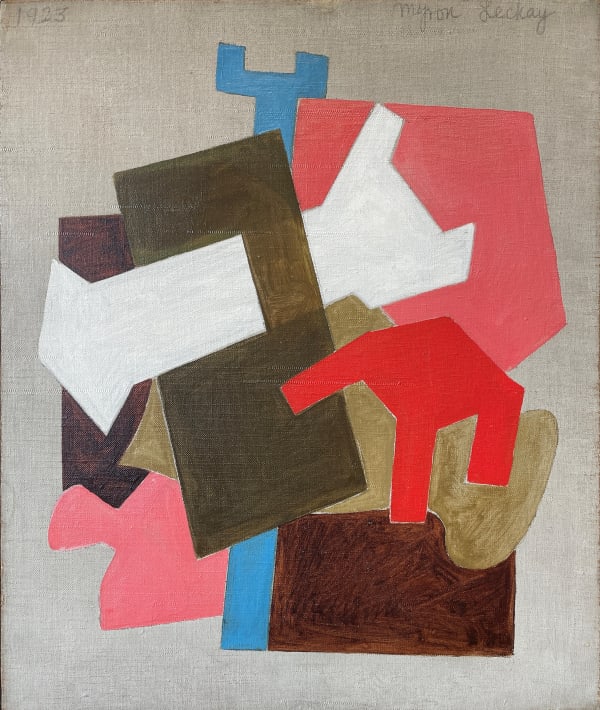Works
Biography
Known for his delicate colorism and graceful abstract designs, Myron Lechay created landscapes and city views that have been compared to Stuart Davis's work of the 1920s and Milton Avery's art of the 1940s.
Lechay was born in Kiev, Russia. After emigrating to the United States with his family in 1906, he attended public schools. He received his initial art instruction at the National Academy of Design.
Lechay's first recognition occurred when the art and antiques dealer, F.W. Lawlor, observed him copying works by the Old Masters at the Metropolitan Museum of Art. Lawlor began to purchase works by Lechay on a regular basis, allowing the artist to support himself from his art.
By the 1920s, Lechay was participating in the New York avant-garde art scene. He became acquainted with leading American modernists such as Stuart Davis and became a member of the Société Anonyme, where he became familiar with the art of American modernists as well as progressive European artists including the Dadaists, Marcel Duchamp and Francis Picabia.
In the summer of 1921, Lechay joined Davis in the art colony of East Gloucester, Massachusetts. Lechay later wrote: "Stuart and I frequently met to talk of modern painting and poetry. Stuart explained what distinguished modern painting from all other kinds and I gathered impressions and opinions, new and invaluable." At Whitney Studio Club exhibitions, the works of Lechay and Davis were often hung side by side, no doubt because of their stylistic affinities.
In the 1920s, Lechay's career was launched when he was 'discovered' by Valentine Dudensing of the Valentine Gallery. Dudensing began to include the artist in his group shows, and gave him a retrospective exhibition in 1932, four one-man shows and a later retrospective in 1947. Critics applauded Lechay's economy of means and compared him to the French painters Henri Matisse, Piet Mondrian, and Raoul Dufy, whose work was also shown by Dudensing.
Lechay's summer sketching forays took him not only to Gloucester, but also to Marblehead and Nantucket, also in Massachusetts, and to Kennebunkport, Maine. Between 1921 and 1929, he worked in New Orleans, producing a group of works that received critical acclaim.
Lechay maintained a studio in New York City from the 1930s until his death in 1972. In addition to his showings at the Valentine Gallery and the Whitney Studio Club, he exhibited at the Carnegie Institute, the Brooklyn Museum, the Newark Museum and the Pennsylvania Academy of the Fine Arts. His work is represented in the Heckscher Museum, Huntington, New York; the Des Moines Art Center; Iowa; the Sheldon Memorial Art Gallery and Sculpture Garden, Lincoln, Nebraska; the Davenport Art Museum, Iowa and in many other public and private collections.
Lechay was born in Kiev, Russia. After emigrating to the United States with his family in 1906, he attended public schools. He received his initial art instruction at the National Academy of Design.
Lechay's first recognition occurred when the art and antiques dealer, F.W. Lawlor, observed him copying works by the Old Masters at the Metropolitan Museum of Art. Lawlor began to purchase works by Lechay on a regular basis, allowing the artist to support himself from his art.
By the 1920s, Lechay was participating in the New York avant-garde art scene. He became acquainted with leading American modernists such as Stuart Davis and became a member of the Société Anonyme, where he became familiar with the art of American modernists as well as progressive European artists including the Dadaists, Marcel Duchamp and Francis Picabia.
In the summer of 1921, Lechay joined Davis in the art colony of East Gloucester, Massachusetts. Lechay later wrote: "Stuart and I frequently met to talk of modern painting and poetry. Stuart explained what distinguished modern painting from all other kinds and I gathered impressions and opinions, new and invaluable." At Whitney Studio Club exhibitions, the works of Lechay and Davis were often hung side by side, no doubt because of their stylistic affinities.
In the 1920s, Lechay's career was launched when he was 'discovered' by Valentine Dudensing of the Valentine Gallery. Dudensing began to include the artist in his group shows, and gave him a retrospective exhibition in 1932, four one-man shows and a later retrospective in 1947. Critics applauded Lechay's economy of means and compared him to the French painters Henri Matisse, Piet Mondrian, and Raoul Dufy, whose work was also shown by Dudensing.
Lechay's summer sketching forays took him not only to Gloucester, but also to Marblehead and Nantucket, also in Massachusetts, and to Kennebunkport, Maine. Between 1921 and 1929, he worked in New Orleans, producing a group of works that received critical acclaim.
Lechay maintained a studio in New York City from the 1930s until his death in 1972. In addition to his showings at the Valentine Gallery and the Whitney Studio Club, he exhibited at the Carnegie Institute, the Brooklyn Museum, the Newark Museum and the Pennsylvania Academy of the Fine Arts. His work is represented in the Heckscher Museum, Huntington, New York; the Des Moines Art Center; Iowa; the Sheldon Memorial Art Gallery and Sculpture Garden, Lincoln, Nebraska; the Davenport Art Museum, Iowa and in many other public and private collections.
Enquire

